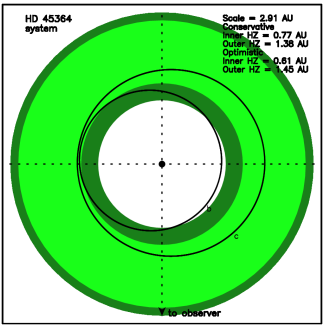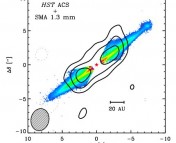Title: New Dynamical State and Habitability of the HD 45364 Planetary System
Authors: Zhexing Li et al.
First Author’s Institution: Department of Earth and Planetary Sciences, University of California, Riverside
Status: Published in the Astrophysical Journal [open access]
As more and more new extrasolar planets are being discovered in recent years, scientists are constantly faced with new observations that challenge how we understand the mechanisms of planetary system formation. While for hundreds of years our Solar System was the only example of a planetary system astronomers had to go on, nowadays we have over 5000 confirmed exoplanets in over 3000 confirmed systems, lots of which do not resemble our own. This has led to many theories about stellar system formation, evolution, dynamics, and stability, which look to fit the plurality of planetary system architectures we observe into a more accurate understanding of the cosmos.
Today’s paper focuses on the system known as HD 45364. Back in 2009, this star was found to host two gas giant planets in a particularly interesting orbital configuration: both planets appeared to orbit in a 3:2 mean motion resonance, and both were also within the system’s habitable zone. This was the first exoplanetary system discovered to have such characteristics.
A Resounding Discovery
Mean motion resonance (‘MMR’) is a phenomenon that occurs when bodies that orbit the same object do so with orbital periods that are integer ratios of each other. When this occurs, the bodies exchange angular momentum with each other and influence each other gravitationally in a much stronger manner than if they were out of resonance, due to the fact that the interactions become periodic and repetitive. This setup can often be favored from an energetic point of view, and make the system more stable, such as in the case of three of Jupiter’s moons – Ganymede, Europa, and Io – which exhibit an MMR of 1:2:4 as they orbit around Jupiter. It can also be unstable, altering the orbit of bodies that fall into these resonances; such as the Kirkwood Gaps in the Asteroid Belt, where asteroids that fall into MMRs with Jupiter are ejected from the belt.
Another relevant observation about this particular system is the fact that there are two gas giants within its habitable zone. A planetary system’s “habitable zone” is usually defined as the range of orbital distances around a star at which a planet could host liquid water on its surface, based on the amount of heat and energy said planet receives from its star, and is historically important when discussing ideas of habitability.
In our case, this observation is interesting because the best theories of planetary formation require gas giants to form outside the forming system’s snow line; far enough away from the star such that volatile gas compounds are able to condense and lighter gases such as hydrogen do not evaporate away. Since the snow line is much further from the star than the habitable zone, it suggests that both these planets must have formed (or started to form) further away, and then migrated inward.
The migration is where the observed possible 3:2 mean motion resonance between the planets comes in. The innermost planet orbits the star in ~227 days, while the outermost one has a ~343 day orbit (about 1.5 times the orbital period of the previous one). This ratio is a sign that the orbits of the two planets have likely gravitationally influenced each other in some way – either forming this way, or migrating into this resonance.
A System, Given Form
The initial study of HD 45364 in 2009 was based on 58 radial velocity measurements taken over 1583 days. Based on these observations, the initial description of the system purported that the two gas giants orbited within the system’s habitable zone, on slightly eccentric orbits, and with a 3:2 MMR between them. These observations also suggested there would be strong gravitational interactions between the two planets due not only to their resonance but the proximity of their orbits at closest distance of approach, due to this eccentricity (see Figure 1).

Two possible formation and migration scenarios for the system were proposed due to the system’s interesting configuration. In Scenario One, the planets accreted most of their mass before migrating inwards. The second planet would have then experienced a much faster inwards migration, and thus would have sped past the more stable 2:1 MMR configuration into the observed 3:2 MMR configuration.
Scenario Two suggested the planets began moving inwards while they were still very small, accreting their mass while migrating. Thus they would not have had enough mass to stop each other at the stable 2:1 configuration when they reached that point, instead reaching their critical mass at the 3:2 MMR orbital stage.
An interesting quandary, however, was that each scenario predicted different outcomes for the system’s final orbits. Scenario One predicted the planets would orbit at a much more circular and less eccentric orbit than was initially claimed to have been observed. For Scenario Two, simulations ran on that scenario showed different possible outcomes, based on initial assumptions about orbit and eccentricity decay: one similar to Scenario One, and one that matched the observed orbits of the system more closely. The bottom line was that more observations of HD 45364 would be needed to distinguish between the two scenarios, and also between different physical assumptions for each scenario.
With New Observations Come New Interpretations
Now over ten years later, the authors of today’s paper have re-examined the system with a total of 121 data points taken during a period of over 6500 days. The new data also included instruments and data analysis tools that improved the measurement precision, and as such provide a more accurate and complete picture of the planetary pair’s orbit.

This new analysis showed several differences from the previous solution. In particular, the orbit of the two gas giants was calculated to be much closer to circular than in the earlier paper. The orbits no longer come nearly as close to one another, and planet ‘b’s orbit now lies entirely within the optimistic habitable zone. Furthermore, while the 2009 paper claimed that there should be strong planet-planet interactions, the new data showed that these interactions are in fact negligible throughout the entire dataset.
But perhaps the most interesting discovery was that the resonances between the two planets did not appear to hold at 3:2, but that the system is in fact in a “quasi-resonance” state. This means that the planet pair is moving in and out of resonance periodically, over a period of ~250 years based on the authors’ simulations.
As such, these updates to the system’s orbital parameters suggest that planetary formation theories that favor circular orbits and take into account the new dynamics of the system should be favored over those that don’t. Updated discoveries like this help constrain the range of possible formation theories that result in such a system – for example, with the new orbital parameters, Scenario One seems more likely than before, while certain initial parameters for Scenario Two’s simulations can be favored over the others. This expands not only our understanding of this system in particular, but what system formation mechanisms are more likely in general.
Finally, this experiment shows the importance of continued monitoring and data collection of planetary systems that have already been discovered, as better and larger datasets can have a large impact on how we understand planetary system dynamics and formation theories.
Astrobite edited by Zili Shen
Featured image credit: Yves LC/Wikimedia Commons




